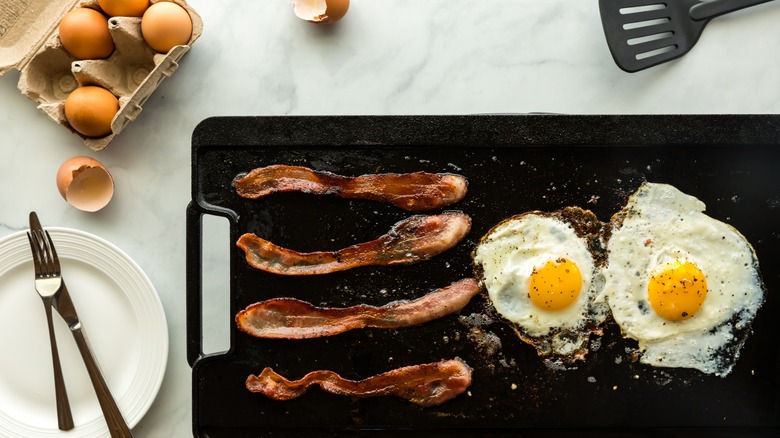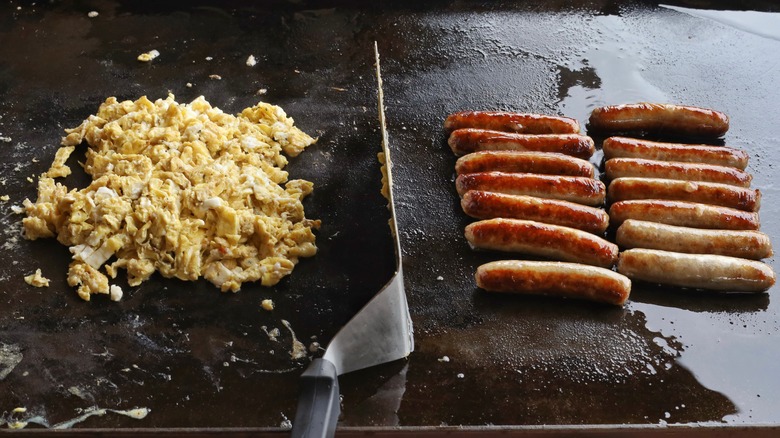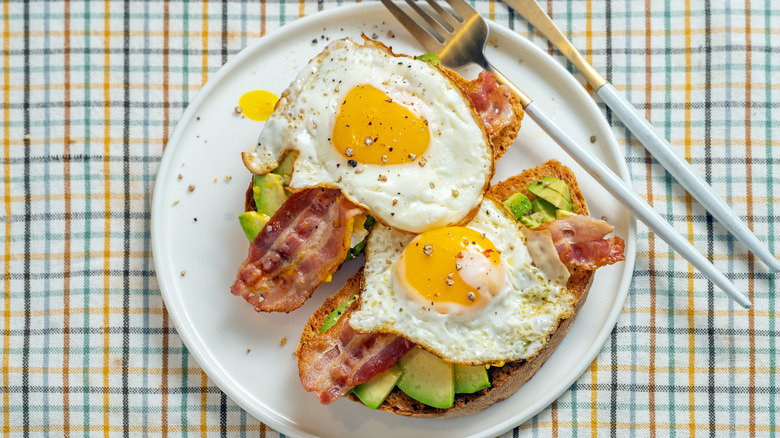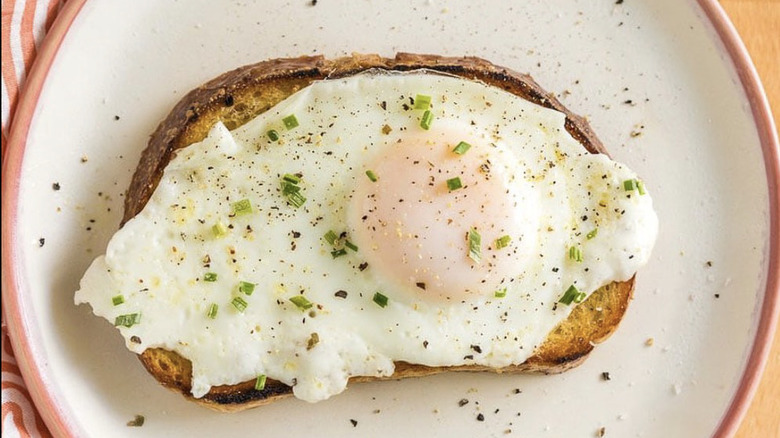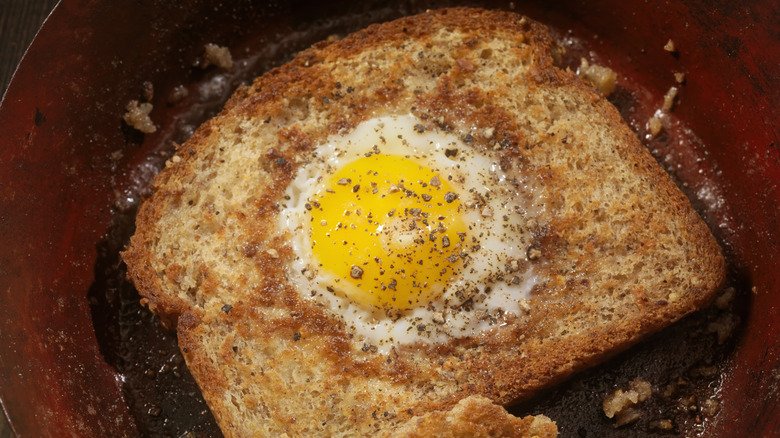5 Ways To Master Cooking Eggs On A Griddle
Most often used as a part of a delicious breakfast, eggs are a favorite choice in part because they're so versatile. Not only are there several ways to prepare them, but there are also just as many devices to use to make sure your eggs are cooked to perfection. Of course, we're all familiar with the various ways to make eggs in a skillet — from a classic French omelet to soft and fluffy scrambled eggs, but different methods produce different flavors and fit better for the convenience of certain circumstances. For example, using a sous vide cooker will give you eggs with an ultra-fluffy and luxurious texture, while an air fryer will replicate fried eggs without the added oil.
An outdoor griddle is great for cooking your eggs because it offers a large cooking surface that's evenly heated throughout. This gives you the opportunity to cook several servings at once, which can be hugely convenient when feeding a large crowd. Additionally, thanks to the steady flame beneath the surface, griddles can get really hot really fast, aiding you even further in preparing your meal more quickly than you could on your stovetop. The methods for cooking eggs on your griddle are certainly similar to skillet cooking, but a bit of tweaking and, in some cases, an extra dose of creativity are needed to make the most of your griddle eggs.
Scrambled eggs
The griddle makes it easier than ever to whip up a large batch of soft and fluffy scrambled eggs, evenly cooked with plenty of air incorporated into them. For scrambled eggs, always start by cracking your eggs into a bowl, not directly onto the griddle. Use salt as a finishing sprinkle rather than a main ingredient to avoid creating rubbery eggs. Whisk the eggs well until the yolks and whites are well combined, then add a splash of water to encourage steam, which will improve the texture by creating a fluffier egg.
When making scrambled eggs on the griddle, you'll want to start with medium-low heat. Unlike with fried eggs, scrambled eggs do better when cooked low and slow. You'll also want to be sure to keep your griddle on a level surface. If it's uneven, your eggs will likely run, and they may drip right into your griddle's drain, wasting the batch. While not required, you can add great flavor to your dish by melting 1-2 tablespoons of butter on the griddle before you start cooking.
Slowly pour the eggs on the center of the warm griddle and use a large metal spatula to gently begin scraping them together. Continue folding them inward, breaking apart large pieces as you go, gradually heating and scrambling to ensure even cooking. Your eggs will only need about 5-7 minutes to become fluffy and light yellow in color, signifying that they're done cooking and ready to be salted and served.
Omelet
The best part of this breakfast favorite is that you can load it up to your heart's desire with the most popular omelet fillings to whip up a delicious and creative dish every time. One key to successful omelette-making is cooking with residual heat. Griddles can get very hot, which doesn't allow you much time to avoid burning your eggs, or even enough time to think about your next move. Omelets can be cooked in about 5 minutes from start to finish, but they require more setting than a fried egg, for example.
You may be wondering if you should pre-cook the fillings for your omelet first, and the answer is a resounding yes. The eggs will cook much more quickly than your peppers, mushrooms, or meats, so a little extra preparation ahead of time will make for a smoother process later. You can also quickly prepare any of these fillings right on your griddle before pouring the eggs.
Preheat your griddle to medium-low heat and brush the cooking surface with a light layer of butter or oil. Whisk the eggs in a bowl, then turn off the heat. Slowly pour the eggs onto the griddle in a plate-sized, round shape. Add your toppings, then let the mixture set until the eggs are cooked through. This should only take about 3-5 minutes, then your omelet will be ready for a delicate fold-over before serving.
Fried eggs
At their simplest, fried eggs are just eggs cooked in frying oil, but the final result can vary greatly depending on cooking time and even whether or not you flip them. The blanket term can mean everything from sunny-side-up eggs with firm whites and a soft, dippable yolk, to eggs over-hard, with both a cooked-solid yolk and white. No matter the type, fried eggs are perfect for everything from breakfast sandwiches to brunch burgers. And just like in your favorite diner, the griddle is an excellent tool for cooking them.
To cook fried eggs on the griddle, preheat to around medium. You'll want the eggs to start cooking as soon as they hit the steel, but you don't want it so hot that your eggs burn. Once the griddle reaches the appropriate heat, simply crack your eggs directly onto the surface. Sprinkle seasoning on top of the egg and allow it to cook until it reaches the desired firmness.
For sunny-side-up eggs, you don't need to flip at all. However, for over-easy, over-medium, or over-hard eggs, you'll want to carefully flip the egg after about 2 minutes until the whites are set. Then, you can cook the other side for between 2-4 additional minutes, depending on your griddle's temperature and your preferred style of fried egg. Gently inspect the doneness of the yolk using your spatula, and when it's reached the perfect consistency, remove the fried eggs from the cooktop and serve.
Basted eggs
Basting your eggs is as close as you can get to poaching them without using a pot of water. While it would technically work to set a saucepan on your griddle and follow the traditional method of making perfectly poached eggs, you can achieve a very similar result with the help of a basting dome or a large oven-safe bowl. Poaching involves gently simmering a cracked egg in a pot of water until the egg white wraps around the yolk and cooks itself into a delicate enclosure. This method produces a fragile yet wonderfully silky egg with a runny yolk that pairs perfectly with your favorite crusty bread. Though you won't be using a pot, griddle basting is similar in that it involves a delicate hand and plenty of water.
To baste an egg on your griddle, first, preheat your device to medium-low heat. Crack an egg into a shallow bowl, being sure to keep the yolk intact, then carefully pour the egg directly on your cooking surface. Using a squirt bottle, surround your egg with a circle of water, and immediately cover it with your basting dome or bowl. While the egg rests underneath the domed covering, the steam created from the evaporated water will gently cook your egg in a delicate and hands-off way. When the egg white is firm but the yolk is still runny, your basted egg will be ready to come off the griddle and be served.
Egg-in-a-hole
Egg-in-a-hole is a fun and complete dish that combines two classic breakfast staples: eggs and toast. You can absolutely prepare this dish in your kitchen, but the griddle makes the process so much faster, cooking the bread and the eggs in no time, and giving you a large cooking surface to make several servings at once.
To make an egg-in-a-hole on your griddle, you'll want to do a little prep work while the griddle preheats to a medium-low temperature. First, cut a small circle, about 2 inches in diameter, in the center of each slice of bread. A small biscuit cutter or cookie cutter works great for this. Then, brush both sides of the bread with butter and place them on the griddle. Let the first side cook for 1-2 minutes, then crack an egg directly in the hole you cut out earlier. Season the egg with salt, pepper, and any other flavorings that match your taste preference, including shredded cheese or chives.
Allow the egg to fry for 3-4 minutes before flipping the piece of toast and egg at the same time. This will allow you to toast the other side of the bread and the top of the egg to finish the dish. Once flipped, an additional 2-3 minutes should give you an over-medium fry. Inspect the doneness of the yolk yourself and adjust the cooking time based on your preferences. Remove your egg-in-a-hole from the griddle and serve it warm.
